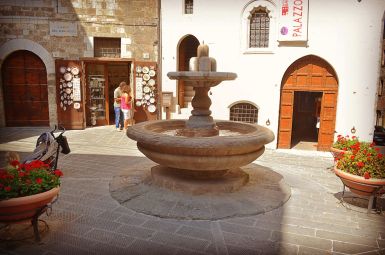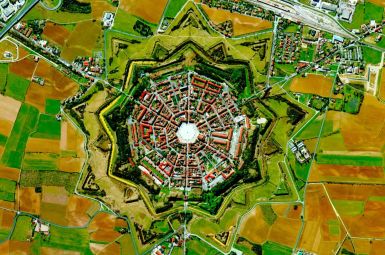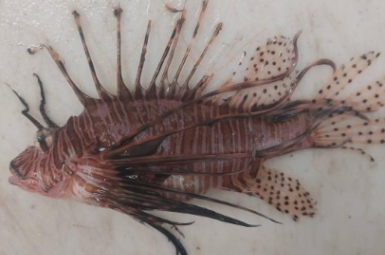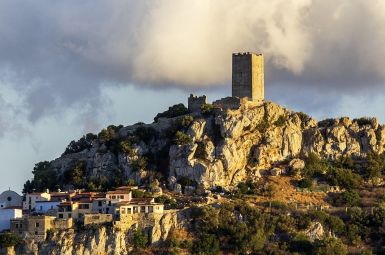
Ferrandina
Il Borgo di Ferrandina
Ferrandina: La Città dell’Olio, dove l’Antico è d’Oro
Ferrandina (MT) non è solo un borgo collinare: è il cuore pulsante dell’olivicoltura lucana, una città che affonda le sue radici nella Magna Grecia e che porta con sé un’eredità storica e gastronomica di inestimabile valore. Arroccata a dominare le valli dei fiumi Basento e Bradano, Ferrandina offre un panorama di uliveti sterminati, un vero e proprio mare d’argento vegetale. Preparati a scoprire un centro che combina sapientemente architettura rinascimentale, spiritualità profonda e un prodotto d’eccellenza riconosciuto a livello mondiale.La Rifondazione Reale e L’Impronta Rinascimentale
La storia moderna di Ferrandina inizia con un atto di volontà regale che ne ha definito l’attuale fisionomia:- Il Nomen Omen: Il borgo preesistente (l’antica Castellum Obbianum o Uggiano) fu rifondato nel 1507 da Federico d’Aragona, Re di Napoli, che lo battezzò “Ferrandina” in onore di suo padre, Ferrante d’Aragona. Con questa rifondazione, la città acquisì un impianto urbanistico più regolare e moderno.
- Architetture della Fede: Il centro storico è punteggiato da imponenti complessi religiosi che testimoniano la fervente vita spirituale. Spiccano il Convento di San Domenico (che conserva un bellissimo chiostro con un disegno stellare nel pavimento) e il Complesso Monastico di Santa Chiara, la cui alta torre domina il panorama cittadino.
L’Oro Liquido: Patria della Majatica
Il vero vanto di Ferrandina è la sua millenaria vocazione olearia, che la rende una delle “Città dell’Olio” italiane.- L’Ulivo Secolare: Il territorio è fittamente coperto da centinaia di migliaia di piante della cultivar autoctona Majatica di Ferrandina. Questo olivo ha una doppia attitudine: produce un olio extra vergine d’oliva delicato e profumato e i suoi frutti sono ideali per la mensa.
- Le Olive Infornate: La specialità inimitabile sono le Olive Infornate di Ferrandina, un prodotto tutelato dal presidio Slow Food. Queste olive nere, lavorate secondo un antico procedimento che prevede una breve scottatura e poi l’essiccazione in forno, acquistano una consistenza e un sapore inconfondibili, esaltati solo con un condimento a base di olio e aromi.
Tracce di Magna Grecia e Industria
Ferrandina è un palinsesto che abbraccia epoche lontanissime.- Il Frantoio Antico: Recenti scoperte archeologiche hanno portato alla luce un frantoio oleario risalente al IV secolo a.C. in località Sant’Antonio Abate, una delle pochissime testimonianze di strutture olearie di età preromana documentate in tutta la Magna Grecia. Un’ulteriore prova della sua ininterrotta tradizione olearia.
- La Ciminiera Storica: Un curioso monumento industriale è la Ciminiera Scorpione, che risale al 1886. Fu il simbolo della prima grande industria della città, che un tempo ospitava filande, frantoi e mulini, testimoniando un’epoca di fervore manifatturiero (quando Ferrandina era nota anche per la produzione di tessuti in lana, la Felandina).
Ferrandina ti invita a scoprire la sua storia solida come la pietra e ricca come il suo olio. Preparati a vivere un’esperienza in cui il gusto e la cultura si fondono in un paesaggio indimenticabile.
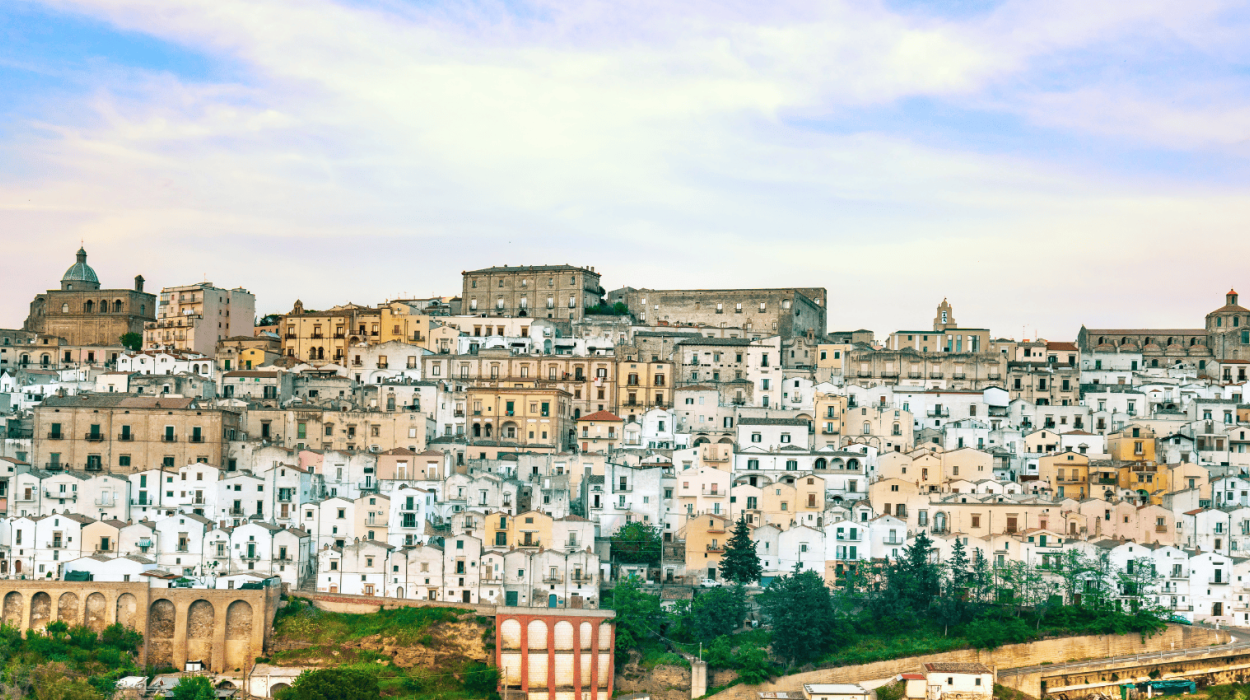
Il Borgo d’Italia
tutto da scoprire ed esplorare
Monumenti
Ferrandina Monumentale: Le Tracce dell’Aragona e l’Eredità dell’Olivo
Ferrandina (MT) è una città costruita per durare, dove ogni monumento celebra un connubio unico: la volontà rinascimentale dei re aragonesi e la millenaria devozione all’olio d’oliva. I suoi edifici, austeri e imponenti, si innalzano da un tappeto di uliveti, raccontando secoli di storia lucana.
Ecco le architetture e i luoghi simbolo che rendono Ferrandina una tappa fondamentale per comprendere il Sud Italia.
1. La Chiesa Madre di Santa Maria della Croce: Il Simbolo Reale
La Chiesa Madre è il cuore spirituale e storico della città, la cui fondazione è strettamente legata alla rifondazione aragonese del borgo nel 1507.
- Architettura e Stile: Si distingue per la sua ampia facciata, in parte di stile romanico, e per la presenza di tre cupole in stile bizantineggiante, un richiamo alle influenze orientali tipiche del Meridione.
- Tesori Reali: All’interno, la chiesa custodisce un’importante statua lignea cinquecentesca della Madonna con Bambino. Una curiosità storica è rappresentata da due statue dorate che raffigurano Federico d’Aragona e sua moglie, la regina Isabella del Balzo, a testimonianza diretta del forte legame tra la monarchia e la nuova città.
2. I Grandi Complesso Monastici: Spiritualità e Potere
Il tessuto urbano di Ferrandina è definito dalla presenza di complessi conventuali di grande pregio, che funsero da centri culturali e spirituali per secoli.
- Complesso Monastico di Santa Chiara: Domina la città con la sua architettura imponente e la caratteristica torre che funge da punto di riferimento visivo. Oggi, parte del complesso ospita il Museo della Civiltà Contadina, un omaggio alle radici agricole del territorio.
- Complesso di San Domenico: Risalente al Cinquecento, questo ex convento domenicano si distingue per il suo restauro che ha valorizzato l’imponente chiostro. I suoi sotterranei, un tempo utilizzati per la sepoltura dei frati, aggiungono un tocco di mistero e storia.
3. Il Monumento all’Archeologia Industriale: La Ciminiera Scorpione
Un monumento che esce dal circuito religioso e nobiliare è l’iconica ciminiera, testimone del breve ma intenso periodo industriale della città.
- L’Era della Lana: La Ciminiera Scorpione, risalente al 1886, è ciò che resta della prima grande industria di Ferrandina. Era un complesso che ospitava filande per la lavorazione della lana, attività che rese celebre il tessuto locale (Felandina), oltre a frantoi e mulini. È un simbolo visibile della capacità della città di reinventarsi economicamente.
4. Il Castello di Uggiano e le Radici Antiche
A breve distanza dal centro, i resti dell’insediamento originario di Ferrandina raccontano una storia millenaria.
- Castellum Obbianum: I ruderi del Castello di Uggiano si ergono in posizione isolata su una collina, sentinella solitaria della valle del Bradano. Sono la traccia visibile del nucleo abitativo medievale che fu abbandonato e poi rifondato dagli Aragonesi, costituendo la prima identità storica del luogo.
A Ferrandina, ogni pietra parla di un passato nobile e operoso. Sei pronto a ripercorrere le vie dove il Barocco incontra l’olio e la storia d’Italia?
Curiosità
Ferrandina Segreta: Tra Giganti d’Ulivo e Segreti della Magna Grecia
Ferrandina (MT) non è solo una tappa sulla mappa lucana, è un’esperienza sensoriale e storica, un luogo dove la nobiltà aragonese e la sapienza contadina si fondono sotto l’ombra di ulivi millenari. Questa Città dell’Olio, con i suoi panorami mozzafiato sulla Valle del Basento, nasconde curiosità che spaziano dall’archeologia al presidio gastronomico.
Ecco i segreti e i dettagli che rendono Ferrandina una destinazione unica.
1. Il Patriarca e l’Eredità dell’Oro Verde
La curiosità più radicata in Ferrandina è legata alla sua identità olearia, che ha generato un vero e proprio monumento vivente.
- Il Gigante d’Ulivo: Nel territorio di Ferrandina sopravvive l’Ulivo Patriarca, un esemplare maestoso di cultivar Majatica che si stima abbia oltre mille anni di storia. Questo albero è il simbolo della millenaria vocazione agricola della zona, una testimonianza vivente della continuità tra l’uomo e la terra.
- Il Tesoro Archeologico: Questa vocazione non è casuale: scavi recenti hanno portato alla luce un frantoio oleario risalente al IV secolo a.C. in località Sant’Antonio Abate. È un ritrovamento eccezionale, una delle pochissime strutture di età preromana per la lavorazione dell’olio documentate nella Magna Grecia.
2. Il Nobile Battesimo Reale
Il nome e la fisionomia del borgo sono il risultato di un atto di fondazione ben preciso, legato alla Corona di Napoli.
- Il Diritto di Città: Il nome Ferrandina deriva da Ferrante d’Aragona, padre di Re Federico IV di Napoli che rifondò il borgo (originariamente noto come Castellum Obbianum o Uggiano) all’inizio del ‘500. Federico non solo diede alla città un nome regale, ma le conferì anche il titolo di “Civica”, un onore che ne sottolineava l’importanza amministrativa e strategica.
3. Dal Tessuto Reale al Presidio Gastronomico
Ferrandina ha avuto un passato industriale notevole e un presente di alta gastronomia tutelata.
- La Felandina: Nel Seicento e nel Settecento, Ferrandina era rinomata per la produzione di tessuti in lana di alta qualità, in particolare un tipo di panno chiamato la “Felandina”, molto richiesto nel Regno di Napoli. La massiccia Ciminiera Scorpione, resto della prima filanda ottocentesca, è il monumento che ricorda questa gloriosa parentesi manifatturiera.
- L’Oliva Infornata (Presidio Slow Food): L’eccellenza della Majatica è tutelata da un rigoroso disciplinare. Le Olive Infornate di Ferrandina non sono semplicemente olive secche, ma sono sottoposte a un processo tradizionale che prevede una scottatura, la salagione e infine l’essiccazione in forno, che ne esalta la naturale dolcezza, rendendole un Presidio Slow Food.
Ferrandina ti aspetta per svelarti i suoi strati di storia: da un millenario frantoio magnogreco al sapore inconfondibile delle sue olive infornate. Non è solo un luogo da visitare, è un gusto da scoprire. Sei pronto a farti avvolgere dal profumo dell’olio Majatica?
Personaggi
Ferrandina: L’Eredità di Fede, Erudizione e Olio
Ferrandina (MT), forte della sua rifondazione aragonese e della sua ricchezza agricola, ha saputo coltivare non solo ulivi secolari, ma anche figure di grande spessore intellettuale e religioso. I suoi figli più illustri hanno lasciato il segno nella storia ecclesiastica e nell’erudizione, onorando la tradizione culturale lucana.
Ecco le personalità di spicco nate tra gli uliveti della Majatica, che hanno portato il nome di Ferrandina ben oltre i confini della Basilicata.
Donato Antonio Donnini: Il Vescovo e Guida Spirituale (XVIII sec.)
Tra le figure di maggiore rilievo ecclesiastico nate a Ferrandina, Donnini è un esempio della profonda spiritualità e dell’impegno pastorale del territorio.
- Dalla Basilicata all’Episcopato: Donato Antonio Donnini fu un importante uomo di Chiesa, nativo ferrandinese, che raggiunse l’apice della carriera ecclesiastica ricoprendo il ruolo di Vescovo. La sua figura è legata alla storia religiosa del Sud Italia, testimoniando come il borgo sapesse dare i natali a guide spirituali di alto livello.
Giambattista Vico (1668 – 1744): Il Legame con l’Erudizione
Sebbene il celebre filosofo napoletano non sia nativo di Ferrandina, la città ha avuto un legame storicamente significativo con la sua famiglia, contribuendo all’ambiente intellettuale del luogo. Tuttavia, cercando figure indubbiamente nate a Ferrandina, emerge l’importanza di coloro che si sono dedicati alla conservazione e alla trasmissione della cultura locale:
- Gli Storici Locali e la Memoria: La vera celebrità di Ferrandina risiede in tutti quei Canonici, Priori e storici locali che, per secoli, hanno custodito e narrato la storia del borgo. Figure come Donato Antonio Donnini, che si distinsero anche per la loro erudizione, contribuirono attivamente alla conservazione del patrimonio artistico e documentale nelle chiese e nei conventi (come San Domenico e Santa Chiara). Essi furono gli intellettuali che garantirono la continuità culturale dopo la rifondazione aragonese.
La Forza della Collettività: I Maestri dell’Olio e della Lana
A Ferrandina, l’importanza di una figura è spesso misurata dalla sua capacità di innovare e sostenere l’economia locale, un’eredità che si protrae fino ai giorni nostri.
- I Frantoiani e la Majatica: I veri eroi locali sono i maestri frantoiani e i produttori di Olio EVO e Olive Infornate, che hanno difeso e tramandato una tradizione agricola risalente alla Magna Grecia (testimoniata dal ritrovamento del frantoio del IV sec. a.C.). La loro abilità ha reso l’Oliva Majatica un prodotto d’eccellenza riconosciuto in tutto il mondo.
- I Maestri Tessitori: Nel periodo di massimo splendore manifatturiero (XVII-XVIII sec.), i maestri tessitori che producevano la rinomata Felandina (il tessuto in lana tipico di Ferrandina) furono le figure chiave dello sviluppo economico, portando ricchezza e prestigio al borgo.
Ferrandina celebra la sua fama non solo attraverso un nome di origine regale, ma attraverso la forza della sua fede, l’erudizione dei suoi uomini di cultura e la maestria di chi ha saputo trasformare i doni della terra in eccellenze globali. Sei pronto a scoprire l’impronta di questa storia?
Ricette Tipiche
Ferrandina: La Cucina Nobile dell’Olivo e del Grano
A Ferrandina (MT), la gastronomia è un’espressione diretta della sua ricchezza agricola. Posta tra le fertili valli dei fiumi e circondata da un mare di uliveti, la cucina qui celebra la purezza degli ingredienti, con l’olio extra vergine d’oliva Majatica come assoluto protagonista e filo conduttore di ogni ricetta.
La tavola ferrandinese è ricca, genuina e profondamente legata alla tradizione contadina che sa trasformare l’eccellenza in piatti memorabili.
1. L’Eccellenza Assoluta: L’Oliva Infornata di Ferrandina
Non è solo un ingrediente o uno snack: è il prodotto identitario della città, tutelato dal presidio Slow Food.
Olive Infornate (Presidio Slow Food)
Queste olive nere, della varietà autoctona Majatica, vengono lavorate con un metodo tradizionale unico che prevede una breve scottatura, la salagione e infine l’essiccazione nei forni.
- Il Gusto Unico: Il risultato è un’oliva semi-secca, rugosa e carnosa, dal sapore inimitabile, con un perfetto equilibrio tra sapidità e dolcezza. Vengono gustate come aperitivo, condite semplicemente con un filo di Olio EVO Majatica, aglio fresco e scorze d’arancia o limone, oppure utilizzate per arricchire zuppe e sughi.
2. I Primi Robusti: Il Pane e la Semola
La semplicità della pasta fatta in casa e della panificazione sono alla base della dieta storica di Ferrandina.
Pane Cotto e Fagioli (‘U Pan Cutt e Fasciuli)
Una ricetta che esprime il massimo della cucina di recupero e comfort. Il pane raffermo, spesso di grano duro e cotto a forno a legna, viene cotto in un brodo semplice e insaporito.
- La Versione Ferrandinese: Il pane viene “cotto” fino a disfarsi, e unito a una zuppa densa di fagioli (borlotti o cannellini), aglio, un generoso giro di Olio EVO Majatica e, immancabile, un pizzico di peperoncino. È un piatto che scalda e nutre, tipico dei giorni più freddi.
Cavatelli con Sugo di Maiale o Lagane e Ceci
I formati di pasta corta lucana, come i cavatelli (ricavati con l’uso di un ferro) o le lagane (larghe e piatte), sono conditi con i sapori decisi della carne di maiale o l’umiltà dei legumi.
- Il Ragù Dello Jonio: Il sugo è spesso un concentrato di pomodoro cotto lentamente con carne suina (costine o salsiccia) o carne di agnello, che sprigiona un sapore ricco e avvolgente, perfetto per la pasta fatta a mano.
3. I Secondi della Tradizione Agricola
Salsiccia e Broccoletti (o Cardoncelli)
Il contrasto tra il sapore deciso e speziato della salsiccia lucana e l’amaro delle verdure di campo è un classico della cucina contadina.
- Il Raccolto del Campo: La salsiccia, preparata con carni di maiale e aromi tipici (finocchio selvatico o peperoncino), viene cotta in padella con le verdure spontanee o coltivate, come i broccoletti o i funghi cardoncelli quando è stagione. L’olio d’oliva esalta la fusione di questi sapori terrestri.
4. Il Dolce della Semplicità: I Taralli all’Uovo
Tipici delle ricorrenze e delle colazioni, i dolci di Ferrandina sono semplici ma aromatici.
Taralli Dolci all’Uovo (Taralli cu l’ove)
Non vanno confusi con i taralli salati. Sono biscotti secchi, preparati con uova, farina, zucchero e talvolta un pizzico di lievito e scorza di limone o arancia.
- Il Rituale: Questi taralli, dalla forma tonda o attorcigliata, sono perfetti da inzuppare nel latte la mattina o, come vuole la tradizione locale, nel vino cotto (vini cuottu) o nel Moscato dolce.
Lasciati guidare dal gusto inconfondibile della Majatica. La cucina di Ferrandina è un tesoro di sapori antichi, una vera ode alla terra. Sei pronto per questo banchetto autentico?
